The Koni class (NATO reporting name) were fifteen anti-submarine warfare frigate built by the Soviet Union as Project 1159 Del’fin to replace the 1950s Riga class. Fourteen were built in Zelenodolsk shipyard between 1975 and 1988. However the project evolved into multirole Frigates for export. The Koni I sub class were designed for European waters, the Koni II for tropical waters. A single Koni III was kept in the Black Sea to train foreign crews. Only 5 officially remains in service today with the Russian Navy. The design inspired the Petre Bărbuneanu-class corvettes for Romania. They were exported to Bulgaria (1), Algeria (3), Cuba (3), East Germany (3 until 1991), Libya (2), and Yugoslavia (2).
Development
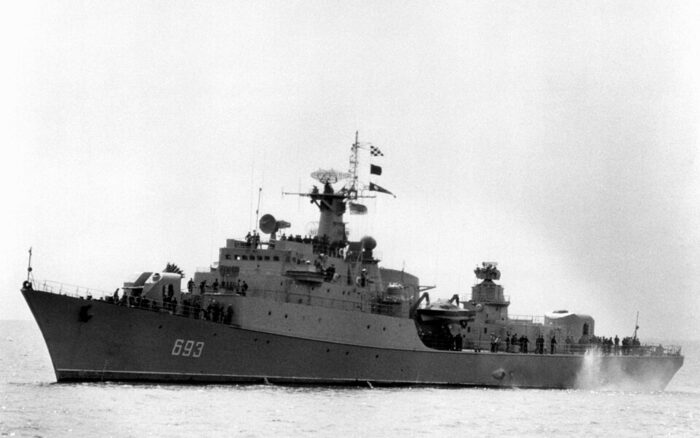
In the 1960s, the export of light patrol ships from the USSR increased significantly notably to boost a degrading economical situation. This forced the development of a “special export patrol ship”, albeit the initial plan was to replace the very old and versatile Riga class, inspired by the Elbing class WW2 German torpedo Boats. Design started in 1968 at the Zelenodolsk Design Bureau. The project was codeed N°1159 according to the tactical and technical assignment (TTZ) issued to the Navy. Yuri A. Nikolsky was appointed chief designer with Captain 2nd Rank A. P. Demeshkevich as chief observer from the Navy. Engineers took into account the experience recently acquired by designing the Project 159 (NATO Petya class) and small ASW vessels of Project 1124 (NATO Grisha class). The design followed a mix of features from the Grisha more than the Petya class, in fact as it was altered to resemble a larger Grisha class with a more balanced armament.
Construction
The lead ship of Project 1159 was named “Dolphin”, giving its name to the entire program. She was laid down at Zelenodolsk shipyard A. M. Gorky, yard No. 340 on 21 April 1973 and completed in December 1975, while her sister Nerpa was laid down in October 1974, a gap of almost two years to test construction and solve early issues. Construction was relatively slow and widely spread over time, with the next ship of Project 1159 (KONI I) laid down in 1977, 1978, 1979 and 1983n the latter competed in 1985 for East Germany. Of this first batch, all were exported, the first to Bulgaria in 1989 after more than a decade service with the Soviet Navy, others to East Germany as completed, and Yugoslavia. Production went on from 1975 to 1987 with 14 ships, six of Project 1159, six Project 1159-T (KONI II) and two of Project 1159-TR (KONI II). All KONI II were exported, with modifications, and both latter classes were of the “tropicalized” variant.
Design of the class
Hull and general design
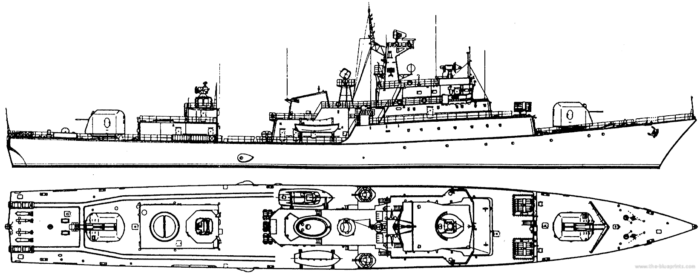
Like seen above, the basic concept was an enlarged Grisha class, with the same overall structure, flush deck hull with blocky structure forward, single funnel, single mast with a smaller radar structure aft, and a heavy armament making them cramped vessels with two twin turrets fore and aft, two twin 30 mm CIWS, two RBU ASW rocket launchers, four anti-ship missiles and 20 anti-air (short range) missiles plus the capacity to carry 20 mines. They were pretty rounded ships with capabilities in all areas. Many features were optional, like NBC protection, less advanced electronics and sensors, or infrared funnel masking. Despite their ASW capability placed first due to teir combo of hull and dipping sonars, their only armament, two rocket launchers, not torpedo tubes and helicopter, made them pretty limited in this aspect.
The hull measured Displacement 95 m (311 ft 8 in) long for a beam of 12.8 m (42 ft 0 in) and draft of 5 m (16 ft 5 in) for an overall standard displacement of 1,140 tons and fully loaded displacement of 1,900 tons. The KONI II had a very different aspect when armed with more powerful missiles (the Libyan ships in particular) and looked imposing despite their small size, one key aspect to show the flag, liked by some navies.
In all versions, they used Soviet radars and sonars. The “tropicalized” KONI II only diverged by air conditioning, a different anti-fooling hull paint and other measures to withstand higher temperatures and ambient humidity.
Powerplant
The main power plant comprised three-shaft repeating the installation of the Project 1124 (Grisha) however, the CODAG system saw the installation of the former high-speed diesel engines on the two outer shafts replaced with less powerful medium-speed diesels in the KONI. The axial shaft was powered by an M-8V afterburning gas turbine rated for 18,000 hp (13,000 KW) and used to boost the top speed to 29 knots, with a search speed, only using the diesels between 20 and 24 knots, and an economic speed at 14 knots, enabling a range of 2,000 nautical miles. The combined diesels produced indeed 9,000 hp (6,700 kW). The total output, combined, 35,000 shp (26,000 kW).
The hull was designed for seaworthiness, to withstand a sea at 8-9 points, but only enabling the use of weapons, up to a 5 points sea. The automation allowed a crew of 110 with a cruising autonomy just based on food supplies limited to just 10 days. However, many navies found ways around it to maintain ships at sea for much more time.
Armament
The armament was made at the base for two AK-726 twin 76 mm (3 in) gun mountings, fore and aft, two AK-230 twin 30 mm (1.2 in) CIWS and AA guns, and four small size SSM of the P-15M Termit launchers fitted in some, but not all ships. In complement of the two RBU launchers on the stepped structure forward of the bridge, some ships also had classic depth charge racks at the poop, and rails for 20 naval mine racks running to the stern. The Libyan vessels were the most different, having a completely new layout to inregrate four P-15M missiles in large tandem canisters forward of the bridge.
4K33 “Osa-M” SAM
NATO SAN-4 “Gecko”. Short range missile system here in a twin arm launcher, reloading vertically. The 4K33 “OSA-M” was introduced in 1972 as the naval version of the system. Each is composed of a two armed Zif-122 retractable launcher with 9M33M missiles. Present on the Gepard-class frigate, Kara-class guided missile cruisers, Kiev-class VTOL cruisers and also the Kirov, Slava and Krivak classes.
Weight: 170 kg, Dimensions: 3,158 x 209.6 mm
Solid propellant rocket motor, 2 s boost, 15 s sustain to 1020 m/s
Range: 15 kilometres (9.3 mi), ceiling 12,000 metres (39,000 ft)
Guidance: RF CLOS dual-thrust rocket motor, Accuracy 5 m
Payload: Frag-HE 16 kg, Contact and proximity fuse
P-15M Termit SSM
(NATO SS-N-2C), heavier and longer than the P-15, with a range of 80 km (50 mi) and several minor improvements. This old missile was initially designed almist like a small jet aircraft, weighting as much as 2,580 kg (5,690 lb) for 6 meters long, powered by a Liquid-propellant rocket, solid-propellant rocket booster to March 0.95. For 1980s standard, easily foolded by all modern ECM, considered an obsolete model. Its shot range was compensated by a powerful payload of 454 kgs (1000 ibs) hollow charge/HE.
AK-726
1960s design, slaved to radars. Studies started in 1954 at TsKB-7 (later Arsenal Design Bureau) under Pyotr Tyurin. Tests started in 1958, pre-service tests started in 1962, full service by June 24, 1964. They were exported also but judged too light and replaced by the AK-100.
⚙ specifications AK-726
Weight Mount: 26t, 76.2mm (3 in)/59 cal. Round:
Elevation −10° to +85°
Loading system Sliding wedge Breech
Muzzle velocity 980 m/s (3,200 ft/s)
Range 15,700 m (17,200 yd), ceiling 11,000 m (36,000 ft)
Guidance Fire Control Radar
Crew 9
Round 5.9 kg (13 lb), Frag, HE, Proximity fuse self-destruction
Rate of Fire 2 × 40–45 RPM
30 mm AK-230
Revolver type, four-chamber drum 30 × 210B mm rounds
Rate of fire 2× 1000 rpm.
Mount 1,9 tonnes, 2 operators.
Range: 4,738m
RBU-6000
⚙ specifications RBU-6000 (1960)/RPK-8 (1990)
Launcher: 3100-3500+4700t, 2 x 2.25 x 1.75 elev.+65° Tr.180°
Specs RGB-60 Rocket: 90R Rocket:
Weight 112.5 kgs 113.5 kgs
Sink Rate 11.6 m/s 11.6 m/s
Range 350/1500 m to 1700/5500 m 600 m to 4,300 m
Seek radius N/A (not homing) 130 m
Target Depth 10 to 500 m Submarines 1,000 m, Torpedoes and divers 4–10 m
Warhead 23 kg, explosive 19.5 kg, shaped.
Sensors
Radar barret-2
Slim Net
Strut curve
Pop group
Hawk Screech
Drum Tilt
Sonar Herkules: hull mounted + dipping sonar
⚙ specifications |
|
| Displacement | 1,140 tons (standard), 1,900 tons (full load) |
| Dimensions | 95 x 12.8 x 5 (311 ft 8 in x 42 ft x 16 ft 5 in) |
| Propulsion | 3 shafts CODAG: gas turbine M8V DN59L4 13.4 MW + 2 diesels: 35,000 shp (26,000 kW) |
| Speed | 27 knots (50 km/h; 31 mph) |
| Range | 3,300 km (1,800 nmi; 2,100 mi) at 26 km/h (14 kn; 16 mph) |
| Armament | 4K33 Osa-M (20), 4× P-15M Termit SSM, 2×2 76.2 mm DP, 2×2 30 mm, 2× RBU-6000 DCL, mines |
| Sensors | Radar barret-2, Slim Net, Strut curve, pop group, Hawk Screech, Drum Tilt, Sonar Herkules |
| Crew | 110 |
Evaluation
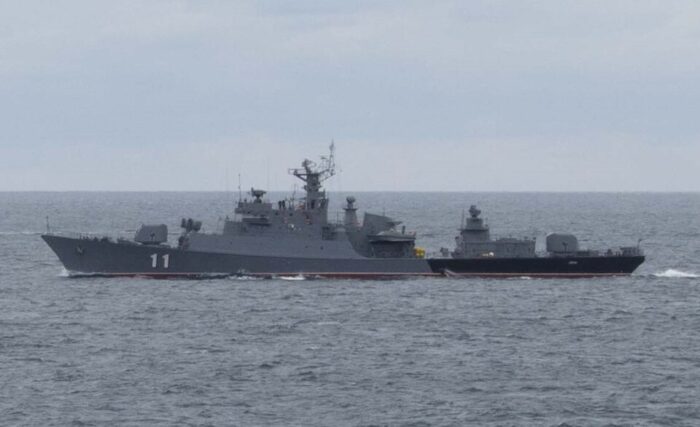
After the export of small-displacement patrol ships from the USSR significantly increased in the 1960s, it was decided to begin developing a special export frigate. In 1968, the Zelenodolsk Design Bureau began creating a ship that received the project number 1159 according to the tactical and technical assignment issued by the Navy. Yu. A. Nikolsky was appointed chief designer of the project, and Captain 2nd Rank A. P. Demeshkevich was appointed chief observer from the Navy.
The design largely took into account the experience of creating the Project 159 frigate and the Project 1124 small patrol ship. The main power plant was three-shaft and almost completely repeated the one according to the Project 1124 scheme, but with the replacement of high-speed diesel engines on the outboard shafts with less powerful medium-speed ones. An M8V afterburning gas turbine with a capacity of 18,000 hp worked on the middle shaft. The patrol ship’s full speed reached 29 knots, and its search speed was within 20-24 knots. The cruising range at 14 knots was 2,000 miles, seaworthiness according to navigation safety conditions was 8-9, and according to the use of weapons – 5 points.
The main armament included the 8E10 self-defense SAM system (export version of the Osa-M SAM system, a twin-boom launcher with 20 SAMs), two twin 76.2 mm AK-726 universal artillery mounts (one on the bow and stern), the same number of twin 30 mm AK-230 anti-aircraft machine guns and 2 RBU-6000 rocket launchers (ammunition 120 RGB-60). In addition, there were bomb release devices and rails for receiving naval mines. The ship’s full displacement reached 1,760 tons, the crew numbered 110 people, and the autonomy in terms of provisions was 10 days.
Modifications. In addition to the basic project, the Zelenodolsk Design Bureau created the Project 1159-T frigate in a tropical version. Six such ships were built for Algeria and Cuba (in the West they received the designation Koni-II class). At the same time, the ships intended for Yugoslavia (Project 1159) and Algeria (Project 1159-T) were additionally armed with four single-container launchers of the P-20 anti-ship missiles, directed towards the stern. Some ships were armed with two quadruple launchers MT-4US for launching SAMs of the Strela-3 type.
Another two ships were built for Libya according to a significantly redesigned Project 1159-TR (Koni-III class). They were distinguished by increased displacement, a modified superstructure design and the presence of two twin launchers for P-20M anti-ship missiles, located on either side of the bow superstructure.
Construction program. The lead ship of Project 1159, named “Dolphin”, was built in 1975 at the Gorky Shipyard in Zelenodolsk (Shipyard No. 340). A total of 6 ships of Project 1159 (nicknamed Koni class in the West) were built from 1975 to 1987, the same number of Project 1159-T and two Project 1159-TR.
Status as of 2008. Initially, all Project 1159 frigates were temporarily part of the USSR Navy and only then transferred for export. Two ships of Project 1159 were in 1978-79. transferred to the GDR (received the names “Rostock” and “Berlin”) and another in 1985 (“Halle”); two – to Yugoslavia in 1980-82 (“Split”, “Kopar”); one project 1159-T – to Algeria in 1980 (“Mourad Rais”) and two in 1982-85 (“Rais Kellich”, “Rais Korfou”); two – to Cuba in 1981-84 (“Mariel”, b/n 356) and another in 1988 (“Monkada”). Two ships of project 1159-TR were transferred to Libya in 1986-87 (“Al Hani”, “Al Qirdabiyan”). After the reunification of Germany in 1990, all three Project 1159 frigates of the GDR Navy were decommissioned and scrapped. Two of the three Cuban Project 1159-T ships were decommissioned in 1996-97. Since 1993, the Yugoslav frigates Split and Kopar were renamed VPB-31 Beograd and VPB-32 Podgorica (both are still in service). In May 1997, the Algerian Project 1159-TR frigate Rais Korfou arrived in Kronstadt at KMOLZ, where it underwent repairs and modernization, which was completed in 2000.
The lead Project 1159 frigate, Delfin, was used in the USSR Navy only as a training ship for training foreign crews and specialists. After completion of the export program, the ship was transferred to the Bulgarian Navy in 1991 and renamed Smeli.
Pr.1159 KONI I

 Delfin (1975)/Smeli (1989)
Delfin (1975)/Smeli (1989)
Delfin was laid down on 21 April 1973, launched on 19 July 1975 and completed on 31 December 1975. In 1989 she was resold to the Bulgarian Navy as “Smeli”, in service as of 2014, since discarded.
 VMS Rostock (ex-Nerpa)
VMS Rostock (ex-Nerpa)
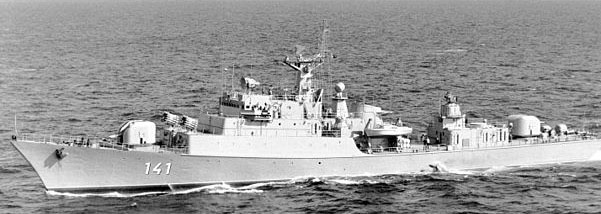
Laid down as Nerpa on 22 October 1974 she was launched on 4 June 1977 and completed on 31 December. Sold in 1978 to East Germany (Volsksmarine name Rostock). She was scrapped in 1991.
The class diverged by having a SA-N-5 MANPAD and 12 depth charges.
 VMS Berlin – Hauptstadt der DDR
VMS Berlin – Hauptstadt der DDR
Laid down as Krechet, laid down on 19 January 1977, she was launched on 3 July 1978 and completed on 31 December 1978. Export to East Germany in 1979, active as Berlin and used a flagship until scrapped in 1990.
 VMS Halle
VMS Halle
Laid down as SKR-149 she was laid down on 8 April 1983, launched on 30 June 1984 and completed on 25 June 1985. Sold the same year to East Germany, and active until the reunification, sold for BU post 1991.
 Split (ex-Sokol)
Split (ex-Sokol)
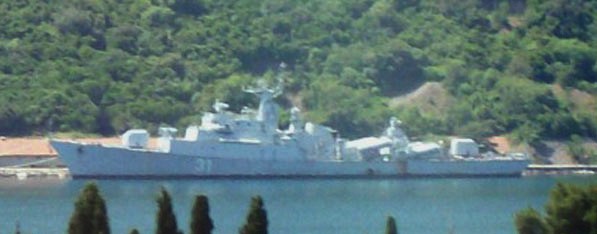
Originally laid down for Yugoslavia as Sokol in January 1978, launched on 21 April 1979 she was completed on 30 November 1979 and sold in 1980 to Yugoslavia as “Split”. Later she was part of the Serbia & Montenegro fleet until scrapped in 2013.
 Koper (ex-SKR-149)
Koper (ex-SKR-149)
Originally laid down as SKR-481 on 25 December 1979 she was launched on 24 December 1981 and completed on 30 September 1982, sold to Yugoslavia as Koper and active until scrapped in 1998.
Pr.1159T KONI II
 Mourad Rais
Mourad Rais
Laid down as KR-482 on 10 June 1978 she was launched on 12 January 1980 and completed on 30 September 1980, sold to Algeria as “Mourad Rais”, active today.
 Rais Kellik
Rais Kellik
SKR-35 was laid down on 11 June 1980, launched on 30 April 1981 and completed on 30 November 1981, sold in 1982 to Algeria as Rais Kellik, active.
 Rais Korfu
Rais Korfu
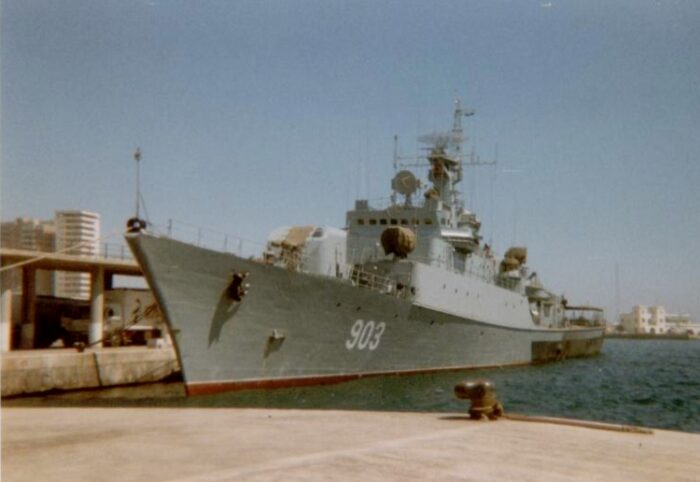
SKR-129 was laid dow on 7 July 1982, launched on 11 November 1983 and completed on 30 August 1984. Sold in 1985 to Algeria as Rais Korfu, active.
 Mariel (350)
Mariel (350)
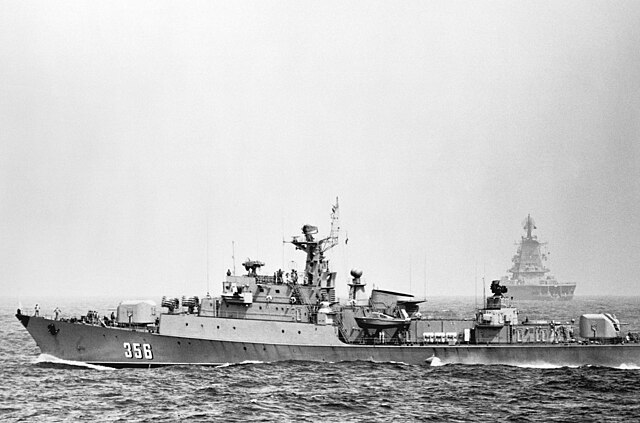
KR-28 was laid down on 17 July 1979, launched on 21 June 1980 and completed on 30 December 1980, sold 1981 to Cuba as Mariel, active.
350, 353, 356: Three ‘Koni’ (Type 1159) frigates were transferred on 24 September 1981, 8 February 1984 and 10 April 1988 respectively. These ships are said to have no names, however the name Mariel was mentioned in connection with the first unit. They are similar to the Algerian version of the type with continuous superstructure. Two of them are usually based at Mariel. These are the most important units of the small Cuban Navy, extant 1995.
 Moncada (353)
Moncada (353)
SKR-451 was laid down in 6 May 1986, launched on 3 May 1987 and completed on 25 December 1987. Sold to Cuba in 1988 to Cuba as “Moncada”. Her name commemorated the assault on the Moncada garrison, signalling the start od the Cuban Revolution.
Renamed Patrol Boat 383, on July 16, 1998 the former “353” was scuttled in shallow water near Varadero at the Parque Submarino Cayo Piedra del Norte as an attraction for divers. She was sunk upright, sitting on the sand bottom under 90 ft (27 m) with her hull number was changed from 353 to 383 prior to the scuttling.
 356 (for spares)
356 (for spares)
SKR-471 was laid down on 24 April 1981, launched on 31 July 1982 and completed on 17 August 1983, sold in 1984 to Cuba as “356”, apparently used for spares for the two others.
Pr.1159TR KONI II
 Al Hani
Al Hani
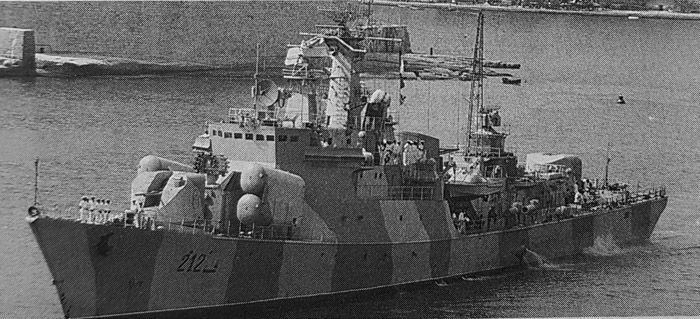
SKR-201 was laid down on 22 September 1982, launched on 27 April 1985 and completed on 30 December 1985, sold 1986 to Libya as Al Hani; in Malta for refit since 2013.
 Al Ghardabia
Al Ghardabia
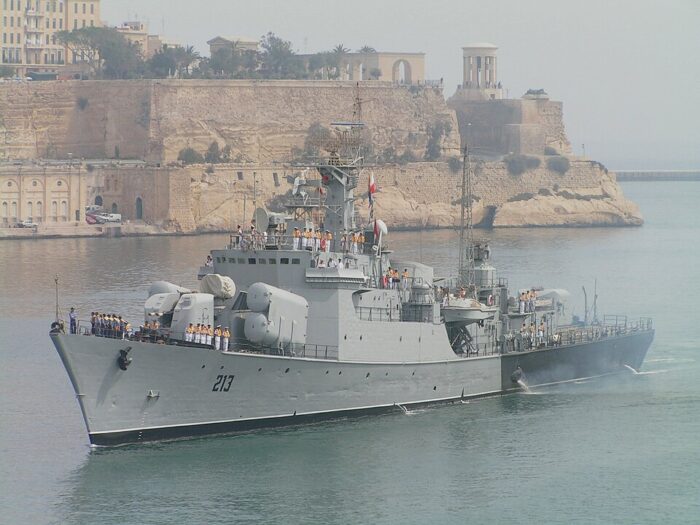
SKR-195 was laid down on 18 April 1985, launched on 27 April 1986 and completed on 25 December 1986, sold in 1987 to Libya as Al Ghardabia, sunk 2011 during the Libyan civil war.
They diverged by having four 406mm torpedo tubes, forward placed missiles, and the latter was damaged by bombing on May 19/20 and August 9, 2011. The remaining Al Hani was captured by the National Transitional Council in Benghazi, and became the flagship of the reorganized Libyan Navy. She is still in Malta for refit since 2013, status uncertain.
Read More/Src
Books
Gardiner, Robert; Chumbley, Stephen; Budzbon, Przemysław (1995). Conway’s All the World’s Fighting Ships 1947-1995.
Couhat Jean. Combat Fleets of the world 1982/1983 Their Ships, Aircraft, and Armament Paris: Editions Maritimes et d’Outre-Mer, 1981
Links
https://russianships.info/eng/warships/project_1159.htm
https://www.militaryfactory.com/ships/detail.php?ship_id=koni-class-project-1159-asw-frigate-soviet-union
https://www.globalsecurity.org/military/world/russia/1159.htm
https://ru.wikipedia.org/wiki/%D0%A1%D1%82%D0%BE%D1%80%D0%BE%D0%B6%D0%B5%D0%B2%D1%8B%D0%B5_%D0%BA%D0%BE%D1%80%D0%B0%D0%B1%D0%BB%D0%B8_%D0%BF%D1%80%D0%BE%D0%B5%D0%BA%D1%82%D0%B0_1159
https://web.archive.org/web/20160428194736/https://fas.org/man/dod-101/sys/ship/row/rus/1159.htm
https://commons.wikimedia.org/wiki/Category:Del%27fin_class_frigate
https://timesofmalta.com/article/libyan-frigate-arrives-for-repairs.492292
https://theshiftnews.com/2018/09/08/us-blocks-release-of-libyan-military-ship-docked-in-malta/
https://web.archive.org/web/20090815064533/http://www.paluba.info/smf/brodovi-jrm/raketna-fregata-(ex-veliki-patrolni-brod-vpbr)-klase-‘koni’/
https://web.archive.org/web/20090724110403/http://www.atrinaflot.narod.ru/2_mainclassships/06_skr_1159/0_1159.htm
https://www.business-gazeta.ru/article/52456

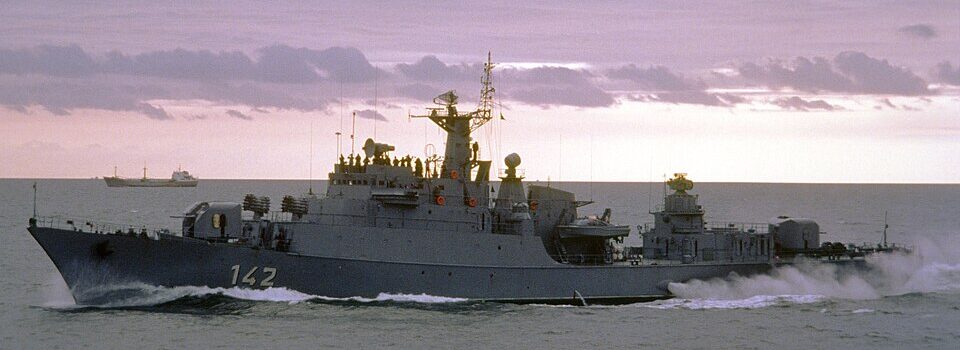

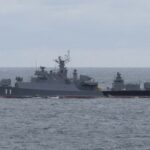
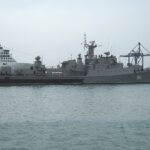
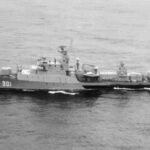
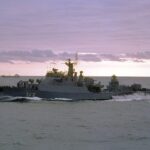
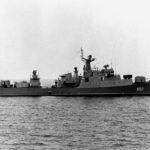
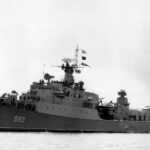
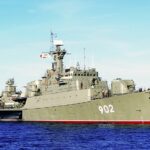
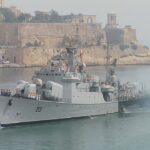
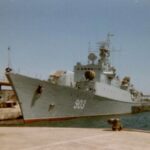
 Latest Facebook Entry -
Latest Facebook Entry -  X(Tweeter) Naval Encyclopedia's deck archive
X(Tweeter) Naval Encyclopedia's deck archive Instagram (@navalencyc)
Instagram (@navalencyc)





 French Navy
French Navy Royal Navy
Royal Navy Russian Navy
Russian Navy Armada Espanola
Armada Espanola Austrian Navy
Austrian Navy K.u.K. Kriegsmarine
K.u.K. Kriegsmarine Dansk Marine
Dansk Marine Nautiko Hellenon
Nautiko Hellenon Koninklije Marine 1870
Koninklije Marine 1870 Marinha do Brasil
Marinha do Brasil Osmanlı Donanması
Osmanlı Donanması Marina Do Peru
Marina Do Peru Marinha do Portugal
Marinha do Portugal Regia Marina 1870
Regia Marina 1870 Nihhon Kaigun 1870
Nihhon Kaigun 1870 Preußische Marine 1870
Preußische Marine 1870 Russkiy Flot 1870
Russkiy Flot 1870 Svenska marinen
Svenska marinen Søværnet
Søværnet Union Navy
Union Navy Confederate Navy
Confederate Navy Armada de Argentina
Armada de Argentina Imperial Chinese Navy
Imperial Chinese Navy Marinha do Portugal
Marinha do Portugal Mexico
Mexico Kaiserliche Marine
Kaiserliche Marine 1898 US Navy
1898 US Navy Sovietskiy Flot
Sovietskiy Flot Royal Canadian Navy
Royal Canadian Navy Royal Australian Navy
Royal Australian Navy RNZN Fleet
RNZN Fleet Chinese Navy 1937
Chinese Navy 1937 Kriegsmarine
Kriegsmarine Chilean Navy
Chilean Navy Danish Navy
Danish Navy Finnish Navy
Finnish Navy Hellenic Navy
Hellenic Navy Polish Navy
Polish Navy Romanian Navy
Romanian Navy Turkish Navy
Turkish Navy Royal Yugoslav Navy
Royal Yugoslav Navy Royal Thai Navy
Royal Thai Navy Minor Navies
Minor Navies Albania
Albania Austria
Austria Belgium
Belgium Columbia
Columbia Costa Rica
Costa Rica Cuba
Cuba Czechoslovakia
Czechoslovakia Dominican Republic
Dominican Republic Haiti
Haiti Hungary
Hungary Honduras
Honduras Estonia
Estonia Iceland
Iceland Eire
Eire Equador
Equador Iran
Iran Iraq
Iraq Latvia
Latvia Liberia
Liberia Lithuania
Lithuania Mandchukuo
Mandchukuo Morocco
Morocco Nicaragua
Nicaragua Persia
Persia San Salvador
San Salvador Sarawak
Sarawak Uruguay
Uruguay Venezuela
Venezuela Zanzibar
Zanzibar Warsaw Pact Navies
Warsaw Pact Navies Bulgaria
Bulgaria Hungary
Hungary

 Bundesmarine
Bundesmarine Dutch Navy
Dutch Navy Hellenic Navy
Hellenic Navy Marina Militare
Marina Militare Yugoslav Navy
Yugoslav Navy Chinese Navy
Chinese Navy Indian Navy
Indian Navy Indonesian Navy
Indonesian Navy JMSDF
JMSDF North Korean Navy
North Korean Navy Pakistani Navy
Pakistani Navy Philippines Navy
Philippines Navy ROKN
ROKN Rep. of Singapore Navy
Rep. of Singapore Navy Taiwanese Navy
Taiwanese Navy IDF Navy
IDF Navy Saudi Navy
Saudi Navy Royal New Zealand Navy
Royal New Zealand Navy Egyptian Navy
Egyptian Navy South African Navy
South African Navy






























 Ukrainian Navy
Ukrainian Navy dbodesign
dbodesign